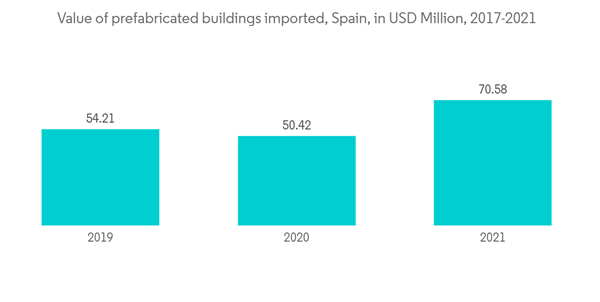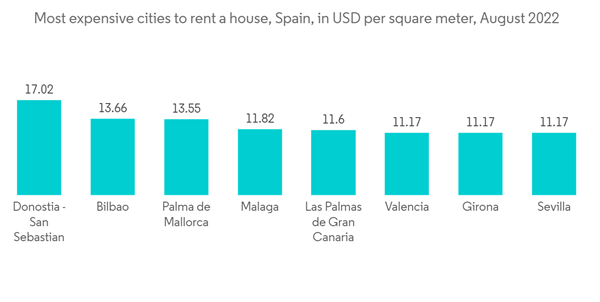Key Highlights
- The future of the Spanish manufactured homes market appears promising, with opportunities in both residential and commercial end-use. The primary drivers of this market are increased construction activity and eco-friendly practices. Increased use of cigarette butt bricks and fly ash in concrete in prefabricated housing is directly impacting the dynamics of the prefabricated housing industry. Casas inHAUS is a market leader in the production of modular homes in Spain. It also exports to other European countries and is currently receiving orders from the United States. Industrialized construction was rare and new in Spain less than ten years ago. However, the market is now growing.
- Homeowners in Spain are increasingly demanding homes as a product with a fixed price and turnkey service. This trend is growing in the new home construction market. Prefabricated houses are gaining popularity in the real estate market due to several opportunities. This type of housing can be customized to meet the owner's needs. The rising rent prices are emphasizing home ownership. More people are opting to live in prefabricated houses due to their advantages.
- The purchase of this type of modular home has tripled in the last three years in Spain, as it has a lower environmental impact than others and is considered an ecological house due to its energy efficiency, both in terms of materials used and the construction process. The market offers the choice of building a low-cost prefabricated house model or high-luxury houses with careful designs. Such advantages are driving the manufactured homes market in Spain.
Key Market Trends
Increasing Home Ownership Driving the Market
- As per the recent INE sales figures for August 2022, there is no decrease in the number of transactions. The number of transactions in August 2022 was still nearly 15% higher than in the same month last year, even though the year had already been exceptionally strong in terms of transactions. Compared to the pre-COVID period, the transactions in August were still 60% and 28% higher than in August 2019 and 2018, respectively. The number of transactions is expected to decline in the coming years. The cost-of-living crisis, combined with rapidly rising mortgage rates and weakening economic growth, is exerting significant downward pressure on real disposable income and creating significant headwinds for the property market.
- On the other hand, the real estate market may benefit from structural growth in the number of households in the coming years. The number of households is increasing faster than population growth due to several nuclear households, which supports the demand in the real estate market. Over the last two decades, more than 20 million new households have been added, representing a 70% increase. Household growth may continue to support the real estate market in the coming years. According to the INE, the number of households will increase by 1.1 million by 2035, representing a 5.3% increase in 13 years, primarily due to a significant increase in the number of single and two-person families.
- High inflation and energy prices are already putting a strain on household purchasing power. While the prospect of rising interest rates may temporarily cause households to improve their purchasing decisions to beat rising interest rates, this effect will gradually fade. On the other hand, demand for real estate remains high, along with the number of transactions and mortgage production. Prices may continue to rise as supply grows slower than the number of households. Spanish house prices have risen slower than in most European countries, making a correction less likely.
Increasing Housing Rental Driving the Market
- According to the INE, a Spanish statistics agency, more than 24% of Spanish households were renting at the end of 2021, one of the highest figures recorded in the last decade. The Spanish population that rents the most are young people with the fewest economic resources to cover the initial costs of purchasing a home. As the home was seen as a refuge for people during the pandemic, it caused cultural changes in the Spanish population. During this period, many Spanish families decided to renovate or even change their homes for more comfortable spaces, which was only possible for many by renting.
- In this new scenario, the evolution of available supply is critical as it was previously limited, and its prices were not always in line with its quality. Creating a quality housing stock tailored to different population groups is one of the main challenges being tackled by many private and public bodies. Madrid and Barcelona, Spain's two most populous cities, have the highest proportions of rental supply, reaching nearly 50% in Madrid at the end of the year's second quarter.
Competitive Landscape
The Spanish manufactured homes market is fragmented with many local, regional, and a few global players. Some of the major players in the market are ALUCASA Mobile Homes, COFITOR Prefabricated Houses, Sismo Building Technology, Custom Home - Casas Modulares Huercal, and Construcciones Modulares CUNI. The rising demand is expected to create opportunities for players to grow in the market with the help of advanced technology, allowing them to provide luxury housing at affordable prices.Additional Benefits:
- The market estimate (ME) sheet in Excel format
- 3 months of analyst support
Table of Contents
Companies Mentioned (Partial List)
A selection of companies mentioned in this report includes, but is not limited to:
- ALUCASA Mobile Homes
- Cofitor Prefabricated Houses
- Sismo Building Technology
- Custom Home - Casas Modulares Hurcal
- Construcciones Modulares CUNI
- Europa Prefabri
- Prefabricated House Lopez SL
- Modular Buildings Cabisuar SA
- Modular Home
- SteelHous
- Atlantida Homes
- Modhouse Arquitectura Modular
- Alhambra Mobilhomes - DPC










